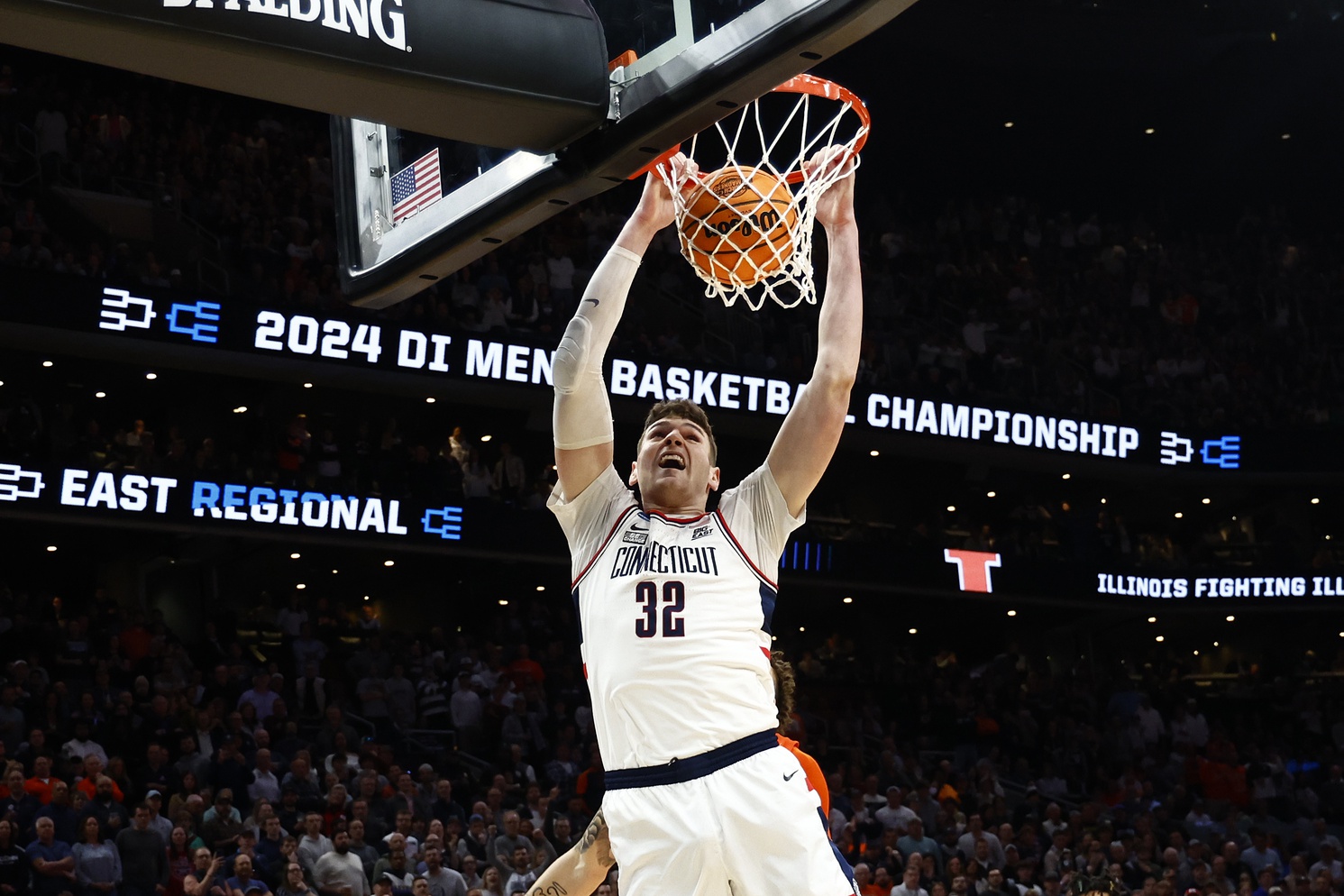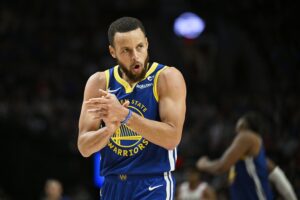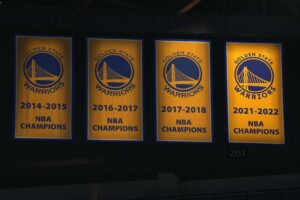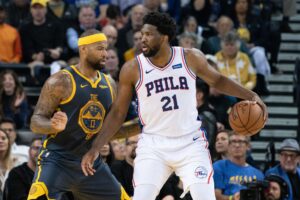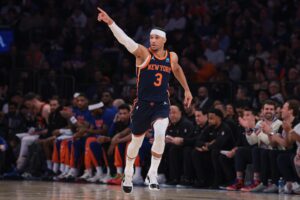It seems the NCAA tournament has attempted to establish that the ‘old-school’ big man still has important significance in basketball. Zach Edey, Donovan Clingan, and DJ Burns are all big men who don’t deal with the perimeter game that’s become so popular today. All of them are also the key focal points for their respective teams’ final four success.
For the purposes of this article, Clingan and Edey will be the focus as they’re legitimate first-round NBA prospects. With both having similar archetypes as massive interior players, many have wondered which is better than the other.
Donovan Clingan Over Zach Edey?
Is The Center Position Dead?
The modern game hasn’t been friendly to the aforementioned ‘old-school’ centers. The old days of playing through the post are long gone. Big men in today’s game spend more time on the perimeter scoring the ball than in the paint. There are few consistent roles left for paint-centric big men who don’t venture out to the three-point line.
One archetype that’s gained consistent success is the ‘vertical spacer.’ These are big men similar to the mold of Dereck Lively, Clint Capela, Mitchell Robinson, Jarrett Allen, or Robert Williams. There are many more big men across the league in this specific role. This category is praised for their plus-mobility relative to size, shot-blocking, and knack for lob dunks due to their good vertical leaping ability. These players have a defined path to success without having to be effective on the perimeter.
Another archetype for paint-focused big men is skilled low-post scorers/playmakers like Alperen Sengun, Jusuf Nurkic, and Domantas Sabonis. Nikola Jokic could be included in his early career, but he’s developed into a threat from everywhere on the court that’s placed him in a different stratosphere. This archetype isn’t as common though since it requires a high basketball IQ, skill, and feel for the game. While these players don’t shoot threes very often on the perimeter, they are elite passers and ball handlers for their size. This causes the defense to stay on their toes as they can be a point guard of sorts for their teams. They also can’t be reliably guarded one-on-one in the post due to the advanced footwork and counter moves at their disposal.
So how close are Edey and Clingan to one or more of these archetypes? Why is Clingan considered a lottery talent as opposed to Edey being projected in the late first?
Clingan or Edey?
First, neither Edey nor Clingan are going to be drafted to be the face of their team’s franchise. Both will be expected to play a clear frontcourt role that’s limited on both offense and defense. Team playstyle and fit will play an important role in each prospect’s success.
Clingan, however, is widely seen as the better prospect compared to Edey. Clingan’s draft stock currently ranges anywhere from eight to twenty, with the consensus being a projected lottery talent. Edey’s draft stock on the other hand is anywhere from 15 to the second round. Edey has been the more dominant college player and is set for a second National Player of the Year award. So why are NBA teams seemingly more interested in Clingan?
Offense
Essentially, Clingan seems more suited to the coveted archetypes mentioned above. To begin with, Clingan’s a better mover in space than Edey as it stands currently. While Clingan isn’t an elite athlete, he’s closer to Walker Kessler or Jakob Poeltl as opposed to Boban Marjanovic. It seems more realistic at the moment that Clingan can become a ‘vertical-spacer’ as compared to Edey. It’s worth noting however that Edey’s on-ball screens are devastating and physical. This may give him a greater chance at success in the pick-and-roll game.
The type of offenses that Purdue and UConn run also help to accentuate the differences between these two players. For UConn, Clingan is asked to play a much more NBA-suitable role. UConn’s offense is one of the most advanced in the country filled with movement, cutting, and setting screens on and off-ball. This causes Clingan to be included in a variety of sets along with often acting as a conductor for handoffs and other actions. In Edey’s case at Purdue, the offense mostly runs through him out of the low post. While this helps his dominant performance in the NCAA, this playstyle isn’t frequently utilized in the NBA. Even if low post basketball is depended on, it’s reserved for superstars like Anthony Davis, Joel Embiid, and Jokic.
Of course, Edey will still provide value as an on-ball screener and play-finisher. Due to his mobility and current playstyle though, there’s less certainty he can translate his game to the next level.
Defense
On the defensive side of the ball, neither prospect is without their question marks. Both Edey and Clingan aren’t considered ‘switchable,’ and don’t project to have above-average agility. This will basically relegate them to only being able to play ‘drop’ coverage at the NBA level. This isn’t a major knock though as drop coverage is what most teams utilize even with mobile big men. The problem is that even in drop-coverage, big men still have to be agile. While ‘dropping,’ centers are meant to stay between the guard and the basket while simultaneously preventing the ‘roll-man’ from catching a lob dunk. A combination of agility, quick/active hands, and some vertical ability are needed to be successful.
Of the two prospects, Clingan looks to have the better blend of these traits. That isn’t to say that Edey’s bigger size can’t help him to overcome these challenges however. It’s just really hard when the guards in the NBA are so good at every area of the game. For example, when defending a player like Trae Young, the big will need to play a cat-and-mouse game. You have to be high enough to prevent a mid-range or three-point shot, but also agile and low enough to prevent the pass for a lob-dunk.
Outside of ball-screen coverage, both prospects should have the ability to block shots given their massive stature. However, timing and quickness are also important factors when trying to block shots at the next level. This is where Clingan’s advantage in mobility also gives him the edge over Edey. Clingan is blocking 2.5 shots per game in just 22.1 minutes, whereas Edey’s averaging 2.2 in 31.6 minutes. Both are great block numbers that figure to go down at the next level, but Clingan’s seemingly quicker hand-eye coordination gives him an advantage.
Final thoughts
Clingan and Edey may be on a collision course to meet in the NCAA championship if they get past Alabama and NC State respectively. Their prospect rankings in no way determine which big man will win the matchup, but fans and scouts alike will no doubt be excited to see them battle.
The center position certainly has become relegated to defined roles and looks much different than the NBA of the past. Both Edey and Clingan will hope to provide a frontcourt anchor and massive interior presence to whatever team drafts them.


